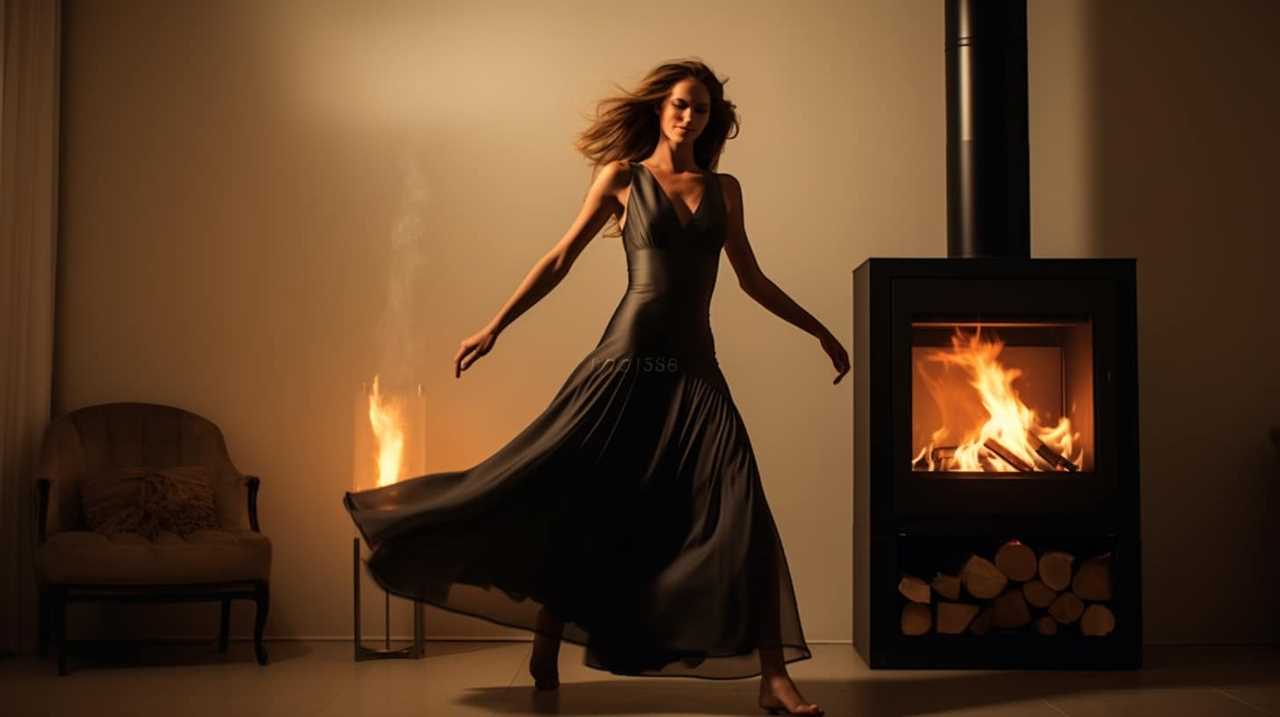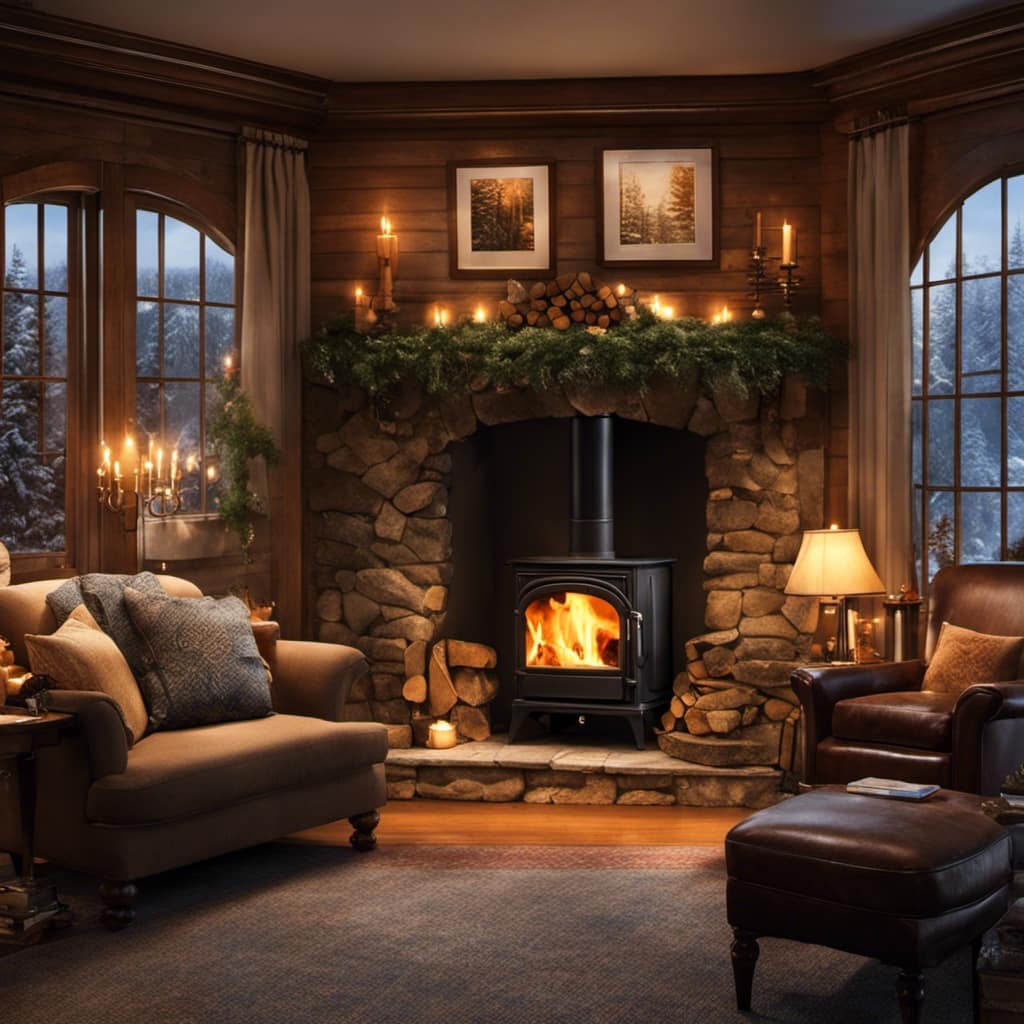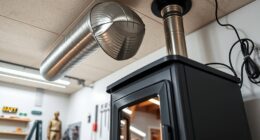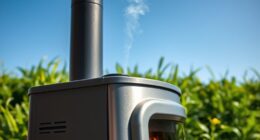As someone who frequently uses wood stoves, I understand the frustration that comes with dealing with clinkers. These stubborn ash deposits can clog up your stove and negatively affect its efficiency.
But fear not! I’m here to share my tried and tested method for removing clinkers effectively. With the right tools and a few simple steps, you’ll be able to keep your wood stove running smoothly and efficiently.
Say goodbye to clinkers and hello to cozy warmth in no time!
Key Takeaways
- Clinkers are solid masses that form in the combustion chamber of a wood stove due to impurities in the wood.
- Clinkers can block airflow, reduce heat output, and increase fuel consumption.
- Removing clinkers requires tools such as a sturdy brush, metal scoop or tongs, protective gloves, and safety goggles.
- Preventing clinker formation involves regular cleaning, using high-quality firewood, proper storage, maintaining airflow, and inspecting the chimney.
Understanding Clinkers: What Are They and Why Do They Form
I’ve always wondered why clinkers form in wood stoves and what exactly they are. Clinkers are solid masses that form in the combustion chamber of a wood stove. Their formation is primarily caused by the presence of impurities in the wood, such as minerals and metals. When the wood is burned, these impurities combine and solidify, forming clinkers.

Clinkers can have a significant impact on the efficiency of a wood stove. They can block airflow, hinder the combustion process, and reduce heat output. As a result, the stove may not burn as efficiently, leading to decreased heat production and increased fuel consumption.
The presence of clinkers can also cause the stove to operate at higher temperatures, increasing the risk of damage to the stove and chimney. Regular cleaning and maintenance are essential to prevent clinker formation and ensure optimal wood stove efficiency.
Essential Tools and Supplies for Clinker Removal
Using a brush and a metal scoop, I can efficiently remove clinkers from my wood stove. When it comes to clinker removal, having the right tools and equipment is crucial for a safe and effective process.
First and foremost, a sturdy brush with stiff bristles is essential for loosening and removing clinkers from the stove’s grates.

Additionally, a metal scoop or tongs are necessary for safely lifting and disposing of the clinkers. It’s important to wear protective gloves to prevent burns and to use caution when handling hot clinkers. Safety goggles are also recommended to protect your eyes from any flying sparks or debris.
Lastly, always ensure that the stove is completely cool before attempting to remove clinkers, as working with a hot stove can be dangerous.
Step-By-Step Guide: Safely Removing Clinkers From Your Wood Stove
After reading the step-by-step guide, I now understand how to safely remove clinkers from my wood stove.
When it comes to clinker removal, safety precautions are of utmost importance. First, make sure to wear heat-resistant gloves to protect your hands from burns. Next, ensure that the stove is completely cooled down before starting the removal process.

Use a metal scoop or tongs to carefully scoop out the clinkers, making sure not to damage the stove or surrounding surfaces. Once the clinkers are removed, it’s crucial to dispose of them properly. Clinkers are highly flammable, so it’s recommended to place them in a metal container with a tight-fitting lid.
Allow the clinkers to cool completely before disposing of them in a non-combustible outdoor area. Following these safety precautions and proper disposal methods will help to ensure a safe and efficient clinker removal process.
Preventing Clinker Formation: Tips for Maintaining a Clean Wood Stove
To prevent clinker formation, it’s important to regularly clean and maintain your wood stove. Clinkers are solid deposits that form when burning wood, and they can cause blockages that reduce the efficiency of your stove. Here are some tips for preventing clinkers and ensuring your wood stove operates at its best.
First, make sure to clean out the ash regularly. Excess ash can contribute to clinker formation, so removing it will help prevent the buildup.

Additionally, using high-quality, well-seasoned firewood can also reduce the likelihood of clinkers. Moisture in the wood can lead to more ash and clinker formation, so it’s important to properly dry and store your firewood.
Furthermore, maintaining proper airflow is crucial. A clogged or dirty chimney can restrict airflow, leading to incomplete combustion and increased clinker formation. Regularly inspect and clean your chimney to ensure it’s clear and in good working condition.
Troubleshooting Common Issues: What to Do If Clinkers Keep Appearing
I can’t figure out why clinkers keep appearing in my wood stove despite following all the maintenance tips. It’s frustrating to constantly deal with these stubborn, hardened deposits that obstruct the airflow and reduce the stove’s efficiency. After conducting thorough research, I’ve discovered some common causes of clinker formation:
-
High Ash Content in Fuel:

-
Using low-quality or improperly seasoned firewood can lead to excessive ash buildup, increasing the likelihood of clinker formation.
-
Avoid using wood with high levels of bark, as it contains more impurities that contribute to clinker formation.
-
Insufficient Air Supply:
-
Inadequate oxygen supply can cause incomplete combustion, resulting in the formation of clinkers.

-
Ensure that the air vents are open and unrestricted to allow proper airflow.
-
Improper Disposal of Clinkers:
-
Dispose of clinkers safely by placing them in a metal container and allowing them to cool completely before discarding.
-
Never dispose of clinkers in a combustible container or directly onto flammable surfaces.

Frequently Asked Questions
Can I Use Regular Household Cleaning Products to Remove Clinkers From My Wood Stove?
Yes, you can use regular household cleaning products to remove clinkers from your wood stove. However, there are more effective clinker removal techniques available, such as using specialized cleaning solutions or mechanical tools.
How Often Should I Remove Clinkers From My Wood Stove?
I clean my wood stove every 1-2 weeks to remove clinkers. There are several methods to remove them, such as using a poker or an ash rake. Regular cleaning helps maintain optimal stove performance.
Is It Safe to Remove Clinkers While the Wood Stove Is Still Hot?
Is it safe to remove clinkers from a hot wood stove? Safety precautions should always be followed when removing clinkers. It’s best to wait for the stove to cool down before attempting to remove them.
Can I Prevent Clinker Formation by Using a Specific Type of Wood?
Using certain types of wood, such as hardwoods like oak or maple, can help prevent clinker formation in a wood stove. These woods have lower ash content, reducing the likelihood of clinkers forming.

Are There Any Alternative Methods for Removing Clinkers From a Wood Stove Without Using a Specialized Tool?
There are alternative removal methods for clinkers from a wood stove without a specialized tool. DIY clinker removal can be done using a wire brush, ash shovel, or even a metal coat hanger.
Conclusion
In conclusion, removing clinkers from your wood stove is a necessary task to ensure its efficiency and longevity. By understanding what clinkers are and why they form, and following the step-by-step guide provided, you can safely and effectively remove them.
Additionally, implementing the tips for preventing clinker formation will help maintain a clean wood stove. Remember, a well-maintained wood stove not only improves heating performance but also reduces the risk of potential issues in the future.
So, keep those clinkers at bay and enjoy a cozy and hassle-free wood stove experience!

Growing up surrounded by the vast beauty of nature, Sierra was always drawn to the call of the wild. While others sought the comfort of the familiar, she ventured out, embracing the unpredictable and finding stories in the heartbeat of nature.
At the epicenter of every remarkable venture lies a dynamic team—a fusion of diverse talents, visions, and passions. The essence of Best Small Wood Stoves is crafted and refined by such a trio: Sierra, Logan, and Terra. Their collective expertise has transformed the platform into a leading authority on small wood stoves, radiating warmth and knowledge in equal measure.











